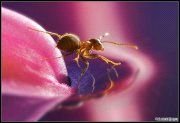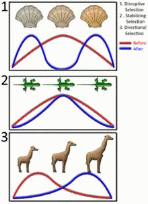Арсланова_Г_А_и_др_Essential_English_for_Biology_Students (1). Kazan federal university
 Скачать 7.01 Mb. Скачать 7.01 Mb.
|
Text 6.2. Natural Selection ■ Essential targets: By the end of this text you should be able to: explain what is meant by “ survival of the fittest”; distinguish between directional selection, stabilising selection, disruptive selection. Pre-reading ■ With a partner consider the following questions and try to answer them. Then scan the text to check your answers. 1. What is natural selection? 2. What environmental factors effect on surviving and producing offspring? ■ Read the given text and make your essential assignments: Survival of the fittest Darwin had the idea that natural selection is the mechanism that drives evolution after reading An Essay on the Principal of Population by Thomas Malthus, a clergyman and political economist. Malthus argued that, in time, the growth of human populations will outstrip the food supply, and that this will lead to “famine, pestilence, and war”. Darwin applied this idea to populations of other animals and of plants. In his book on the origin of species, Darwin wrote: “There is no exception to the rule that every organic being naturally increases at so high a rate that if not destroyed, the Earth would soon be covered by the progeny of a single pair”. In spite of reproducing quickly, no single species has completely over-run the planet, although the populations of some species may be increasing at any one particular time. Darwin concluded that populations are kept in check by a “struggle for existence” as they compete for limited resources and are exposed to disease. Environmental factors that keep populations in check are called selection pressures or environmental resistances. These include: disease competition for resources such as food and a place in which to live predation lack of light, water, or oxygen changes in temperature. Those organisms best suited to the environmental conditions, with characteristics that give them an advantage in the “struggle for existence”, will have the best chance of surviving and producing offspring. Their high natality (birth rate) gives them a selective advantage. On the other hand, those will unfavourable characteristics are more likely to die. Their high mortality (death rate) gives them a selective disadvantage. Darwin argued that this difference in natality and mortality results in natural selection. As environmental conditions change certain characteristics within a randomly varying population are favoured, and natural selection occurs. This has become known as the “survival of the fittest”. In evolution, fitness is defined as the ability of an organism to pass on its alleles to subsequent generations, compared with other individuals of the same species. The “fittest” individual in a population is the one that produces the largest number of offspring that survive to reproduce themselves. Natural selection by “survival of the fittest” means that the genetic characteristics of a population gradually change from generation to generation in response to changes in the environment. As we shall see in the following spreads, natural selection affects a gene pool by increasing the frequency of alleles that give an advantage, and reducing the frequency of alleles that give a disadvantage. (A gene pool is all the genes and their different alleles present in an interbreeding population.) Three types of natural selection Natural selection is not always a mechanism for change. There three different types: stabilising selection, directional selection, and disruptive selection. These are three different ways in which natural selection acts on the phenotypes in a population (the observable characteristics such as colour or height). Typically, the frequency in the population of each phenotype has a normal distribution, described by a bell-shaped curve.  Stabilising selection happens in an unchanging environment. Extremes of the phenotype range are selected against, leading to a reduction in variation (more individuals tend to conform to the mean). Stabilising selection occurs in the natural selection of birth mass in humans. Directional selection favours one extreme of the phenotype range and results in a shift of the mean either to the right or to the left. This type of selection usually follows some kind of environmental change. The long neck of the giraffe is thought to have evolved in this way. Probably, when food was in short supply, only the tallest individuals could reach enough food to survive. They passed on their genes to the next generation. Disruptive selection selects against intermediate phenotypes and favours those at the extremes. This leads to a bimodal distribution (the distribution curve has two peaks or modes) and two overlapping groups of phenotypes. If the two groups become unable to interbreed, then each population may give rise to a new species. Disruptive selection may have contributed to the evolution of Darwin’s finches. Because there were few other birds to compete, finches with short strong beaks had exclusive use of nuts as a food source, while those with long slender beaks had almost exclusive use of insects. Those finches with an average, unspecialised beak were more likely to have been in completion with other species of bird and would have reproduced less successfully. ■ Glossary of essential terms for you to know
■ Your Essential Assignments I. Quick check 1. What is meant by fitness in evolutionary terms? 2. Some individuals of the European swallowtail butterfly (Papilio machaon) pupate on brown stems or leaves; others pupate on green stems or leaves. Two distinct colour forms of the pupae are found, namely brown and green, with very few intermediates. What type of natural selection does this example show? Explain why the intermediate colour forms would be at a selective disadvantage? II. Fill in the missing words:
III. Use monolingual English dictionary and write down what could the words given below mean: species, existence, selection, environment, to occur, gene. IV. Match these words with their definitions:
V. Find English equivalents to the following word combinations:
VI. Give Russian equivalents to the following English terms:
VII. Find synonyms among the pool of words:
VIII. Answer the following questions. Use all information given before: 1. What might lead to famine, pestilence and war? 2. What is called selection pressures? 3. What environmental factors do selection pressures include? 4. What organisms will have the best chance of surviving and producing their offspring? 5. Why does the difference in natality and mortality result in natural selection? 6. What is meant by “survival of the fittest”? 7. How is fitness defined in evolution? 8. What are three types of natural selection? 9. What is the difference between them? IX. Match the sentence halves. Make complete sentences:
X. Read and translate the short text without any dictionary: Fact of life: You may think that natural selection results in change and diversification. This is not always the case. For example, natural selection helps to keep the average birth mass for human babies around 3.3 kg. Not surprisingly, extremely small or large babies have low rates of survival under natural conditions. XI. Food for thought: The extinction of animal and plants species is of great concern today because it is accelerated by direct and indirect results of human activities. However, extinction is a natural process that has occurred since the dawn of life. The 20-30 million species that inhabit the Earth today represent only a minute proportion of all species that have ever existed. Suggest why more than 99.9 per cent of all species that ever evolved have become extinct by natural processes. Explain why the highest rates of extinction in recent times have occurred among species that live only on small oceanic islands. | ||||||||||||||||||||||||||||||||||||||||||||||||||||||||||||||||||||||||||||||||||||||||||||||||||||||||||||||||||||||||||||||||||||||||||||||||||||||||||||||||||||||||||||||||||||||||||||||||||||||||||||||||||||||||||||||||||||||||||||||||||||||||||||||||||||||||||||||||||||||||||||||||||||||||||||||||||||||||||||||||||
